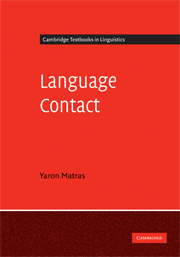Book contents
- Frontmatter
- Contents
- List of figures
- Preface
- List of abbreviations
- 1 Introduction
- 2 An emerging multilingual repertoire
- 3 Societal multilingualism
- 4 Acquiring and maintaining a bilingual repertoire
- 5 Crossing the boundaries: codeswitching in conversation
- 6 The replication of linguistic ‘matter’
- 7 Lexical borrowing
- 8 Grammatical and phonological borrowing
- 9 Converging structures: pattern replication
- 10 Contact languages
- 11 Outlook
- Notes
- References
- Author index
- Language index
- Subject index
6 - The replication of linguistic ‘matter’
Published online by Cambridge University Press: 05 June 2012
- Frontmatter
- Contents
- List of figures
- Preface
- List of abbreviations
- 1 Introduction
- 2 An emerging multilingual repertoire
- 3 Societal multilingualism
- 4 Acquiring and maintaining a bilingual repertoire
- 5 Crossing the boundaries: codeswitching in conversation
- 6 The replication of linguistic ‘matter’
- 7 Lexical borrowing
- 8 Grammatical and phonological borrowing
- 9 Converging structures: pattern replication
- 10 Contact languages
- 11 Outlook
- Notes
- References
- Author index
- Language index
- Subject index
Summary
Defining ‘borrowings’
One of the outcomes of language contact is a change in the structural inventory of at least one of the languages involved, and sometimes of both. This is often viewed as a kind of import of a structure or form from one language system into another. The process is best known as ‘borrowing’ (cf. Haugen 1950); items affected by it are called ‘borrowings’, ‘loans’, or ‘transfers’, and the languages involved are frequently labelled, according to their roles, ‘donor’ and ‘recipient’ (Weinreich 1953).
Though well-established, the term ‘borrowing’ is sometimes criticised. Like any metaphor, it lacks accuracy. For a start, borrowing typically leads to the longterm incorporation of an item into the inventory of the recipient language. Bilingual speakers may well be aware of the origin of a word or morpheme in a particular ‘donor’ language, but this awareness may be blurred over time, especially if active bilingualism declines, or when use of the item spreads to monolingual sectors of the speech community. Not only is there no intention to return the ‘borrowed’ item to its rightful ‘owner’, but for most speakers its original ‘ownership’ may not always be traceable. As Johanson (2002: 8) states, the term ‘borrowing’ may also be misleading in that it implies that the donor language is being ‘robbed’ of an element that belongs to it.
- Type
- Chapter
- Information
- Language Contact , pp. 146 - 165Publisher: Cambridge University PressPrint publication year: 2009

